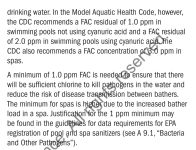- Jun 24, 2021
- 17,121
- Pool Size
- 29000
- Surface
- Vinyl
- Chlorine
- Salt Water Generator
- SWG Type
- CircuPool RJ-60 Plus
@derek_from_maytronics , you said this in another thread, and I didn't want to hijack the thread.Chlorine levels: The 4 ppm limit is real from the manufacturer’s side—they’re trying to protect the internal parts (seals, brushes, etc.) from chemical wear. I totally get that TFP folks run higher levels with CYA in the 70–80 range (same here, SWG pool), but just know that long-term use in 5–10 ppm could shorten the lifespan of the robot. Some people run the bot during lower FC times (early morning, evening, etc.), or just accept the tradeoff and factor in slightly faster wear over time.
Glad you are here! Nice to have people here from manufacturers. I've been curious on this advice...maybe you can help reconcile. See graph below.
- The Dark Blue lines are the range of HOCl at 1 and 4ppm (Maytronics recommended range), which equates to about 0.6 to 1.05ppm HOCl.
- The thin green line represents the low end of the TFP recommended range for all CYA level, which is about 0.05 ppm HOCl.
- This line also represents the lowest level of sanitizing HOCl required to kill algae.
- The top dark green line is the top of the TFP recommended range for 30 ppm CYA which is about 0.1 ppm HOCl.
- The bottom dark green line is the top of the TFP recommended range for 70ppm CYA which is about 0.06 ppm HOCl.
- Note: HOCl is the active (unbound) form of FC, all the other chlorine is bound to CYA.
The TFP ranges for FC, based on CYA, form and maintain about 10 times lower HOCl levels than the Maytronics recommendation of 1-4ppm with 0 CYA (which is what I think Maytronics is protecting against, no?).
What is it about the higher FC levels, and associated CYA, that causes chemical wear? It can't be HOCl.
Thanks for any insights!

Last edited:











